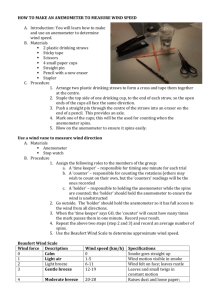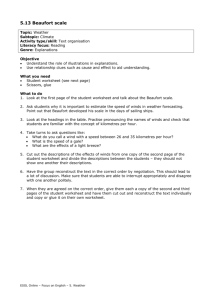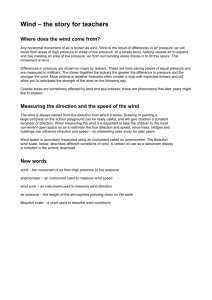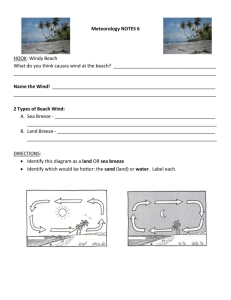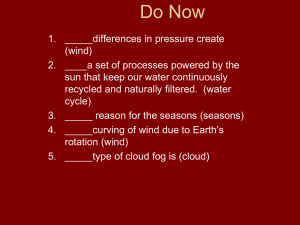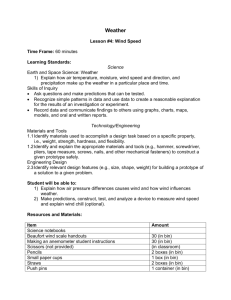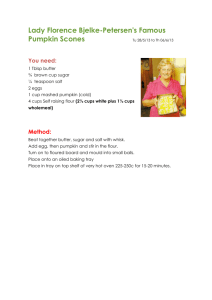Lesson
advertisement
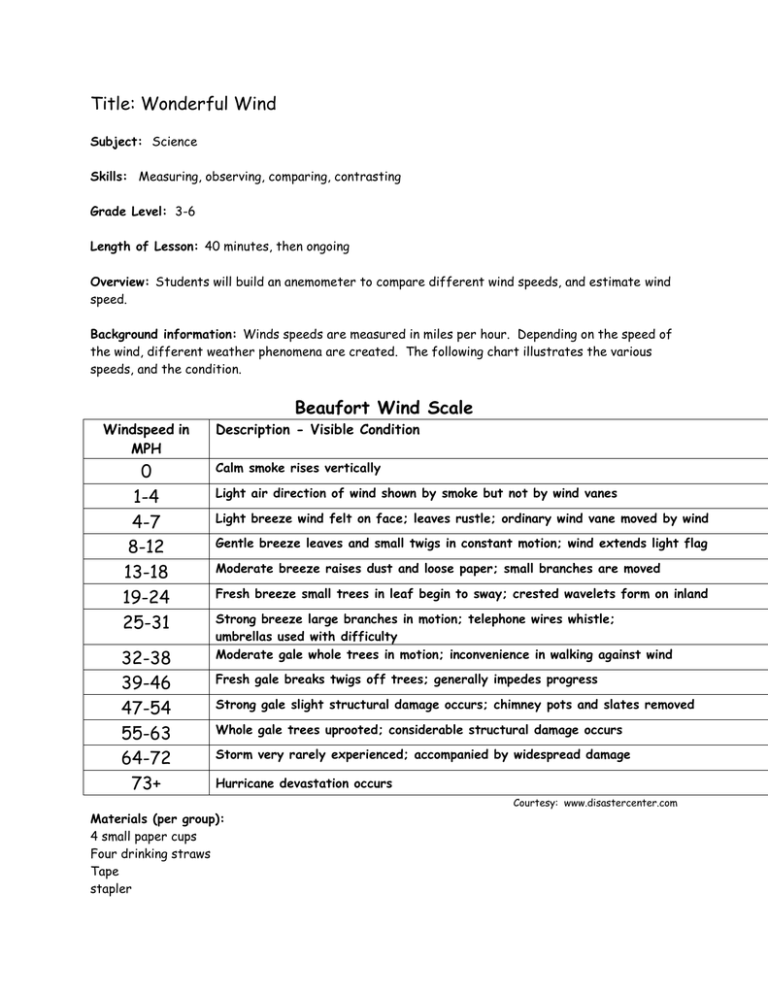
Title: Wonderful Wind Subject: Science Skills: Measuring, observing, comparing, contrasting Grade Level: 3-6 Length of Lesson: 40 minutes, then ongoing Overview: Students will build an anemometer to compare different wind speeds, and estimate wind speed. Background information: Winds speeds are measured in miles per hour. Depending on the speed of the wind, different weather phenomena are created. The following chart illustrates the various speeds, and the condition. Beaufort Wind Scale Windspeed in MPH 0 1-4 4-7 8-12 13-18 19-24 25-31 32-38 39-46 47-54 55-63 64-72 73+ Description - Visible Condition Calm smoke rises vertically Light air direction of wind shown by smoke but not by wind vanes Light breeze wind felt on face; leaves rustle; ordinary wind vane moved by wind Gentle breeze leaves and small twigs in constant motion; wind extends light flag Moderate breeze raises dust and loose paper; small branches are moved Fresh breeze small trees in leaf begin to sway; crested wavelets form on inland Strong breeze large branches in motion; telephone wires whistle; umbrellas used with difficulty Moderate gale whole trees in motion; inconvenience in walking against wind Fresh gale breaks twigs off trees; generally impedes progress Strong gale slight structural damage occurs; chimney pots and slates removed Whole gale trees uprooted; considerable structural damage occurs Storm very rarely experienced; accompanied by widespread damage Hurricane devastation occurs Courtesy: www.disastercenter.com Materials (per group): 4 small paper cups Four drinking straws Tape stapler New pencil Straight pin Wonderful Winds Worksheet Teaching the Lesson: 1. Ask students what happens when a soft summer breeze blows. List answers. Now ask them what happens during a windy fall day. List answers. What happens during a hurricane? 2. Prompt students to discuss the differences among the 3 scenarios. What is changing? Answers should include; increased wind speed, movement of objects, damage, etc. 3. Tell students that wind speed can be measured using an anemometer. They will be making an anemometer and using it to measure different wind speeds. 4. Students should tape 2 straws together, end to end. Then repeat with the other two straws. Finally make an “X” with the two long straws they just created, and tape them together to hold the “X” shape. 5. The wind will be captured in the cups, so they need to be attached to the “X” lying on their sides. Staple one cup to the end of each straw, so that all the cups’ openings are facing the same direction. Mark one cup with an “X”. 6. Have the students push the straight pin through the center of the “X” and into the top of the pencil eraser. They should be able to spin the cups freely by blowing into one of the cups. 7. Students can approximate the speed of the wind by counting how many revolutions take place in one minute. Ten revolutions in one minute is equal to one mile per hour of wind speed. Students can calculate this by counting how many times the cup marked with an “X” goes around from its starting point. 8. Students should take their anemometers outside, and measure the wind speed at various locations on the school grounds. It would be beneficial to compare their results to those taken by an actual anemometer. They should notice trends in areas that are blocked by trees or buildings, open fields, etc. Extension: This activity can be extended by having students investigate the way wind affects a farm or garden. For example, farmers look for dry, slightly breezy days to dry hay that has been harvested. Some seeds are spread by wind, including those of weeds. Farmers cannot spray on windy days. Students could also report how wind can be both helpful and detrimental. NJ Agricultural Society
